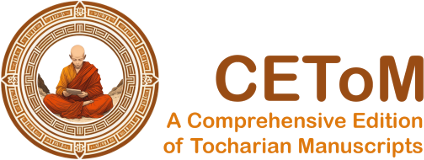Work in progress
Kz-222-ZS-R-02
| Known as: | Kz-222-ZS-R-02; G-Qm12 |
|---|
| Cite this page as: | Adrian Musitz (editor translation commentary). "Kz-222-ZS-R-02". In A Comprehensive Edition of Tocharian Manuscripts (CEToM). Created and maintained by Melanie Malzahn, Martin Braun, Hannes A. Fellner, and Bernhard Koller. https://cetom.univie.ac.at/?m-kz222zsr02 (accessed 04 Jul. 2025). |
|---|
Edition |
| Editor: | Adrian Musitz (editor translation commentary) |
|---|
Provenience |
| Main find spot: | Kizil |
|---|
| Collection: | in situ |
|---|
Language and Script |
| Language: | TB |
|---|
Text contents |
| Text genre: | Non-literary |
|---|
| Verse/Prose: | prose |
|---|
Object |
| Material: |
engraving
on wall |
|---|
| Form: | Graffito |
|---|
Transliteration
| a1 | 6 kṣu ntsa tri cce [c]o cce ne śta rcye ñu ne tai tsyā· ku neṃ mo lmi śi |
|---|
| a2 | nau ṣweṃ tsa mai we¯ ¯ñ pa kā ñce e [ṣ]i – [rṣā] [nä] yke ne si mtsa mai ta re tu ntse [ṣo] tr[i] pai yka re | |
|---|
Transcription
Translation
| a1+ | In regnal year 6, third month, in the cocce dayn6 , fourth month, on day nine, young päkāñ(c) came to this... place along the border (?), with general Molmiśi at the fore. |
|---|
| a2 | They wrote (this as) proof thereof. |
|---|
Other
Commentary
Philological commentary
| * | The transliteration has been taken from Zhao and Rong 2020: 171-173. |
|---|
| * | The transcription has been taken from Zhao and Rong 2020: 171-173. |
|---|
| n1 | Ching 2017: co cce teṃ |
|---|
| n2 | The editors identify Molmiśi with 莫苾 (mòbì, EMC *mak-bjit, LMC *mak-pɦjit) known from Chinese documents. This stretches the limits of phonetic plausibility. How would the cluster -kbj- turn into -lm-, and final -t into -śi? |
|---|
| n3 | Ching 2017: Eti[laṣ]ā[t]o |
|---|
| n4 | The editors read päkāñ(c) , arguing that the c has been dropped because of the following ceṃ . They connect it to Chinese 白 (bái, *baek), a name often given to Tocharians in Chinese documents, glossing it as "provided with (the surname) päk". However, I believe it is much more likely that the form is to be read as päkāñ , and that it is Tocharian and not a loan word. Maybe there is some connection to Greek πέπων, a word meaning "ripe" that can also be used as a term of endearment when addressing a person. From a morphophonological point of view, it would fit very well. |
|---|
| n5 | There is a Chinese character below this word that the editors read as 督 ("supervise" or "governor"). |
|---|
| n6 | The editors believe that coccene is an adjective derivation in -tstse of Chinese 周 (zhou), denoting here the interregnum of Wu Zetian. However, from the context alone, we would much rather expect coccene to denote some kind of (holi)day, since it follows directly after the month. If coccene truly denoted a dynasty, we would expect it to be at the very beginning of the line, before kṣuntsa . For another example of an adjective in -tstse denoting a holiday, see PK LC 10 a7-a8parāce . |
|---|
References
Edition
Zhao and Rong 2020; Ching 2017: 115
Translations
Zhao and Rong 2020: a1 (171ff), a2 (171ff)
Bibliography
Ching 2017
Ching, Chao-jung. 2017. 吐火罗语世俗文献与古代龟兹历史 – Tocharian secular texts and the history of Ancient Kucha. Beijing: Peking University Press.
Zhao and Rong 2020
Zhao, Li, and Xinjiang Rong, eds. 2020. Cave inscriptions in Ancient Kucha. Shanghai: Zhongxi Book Company.


